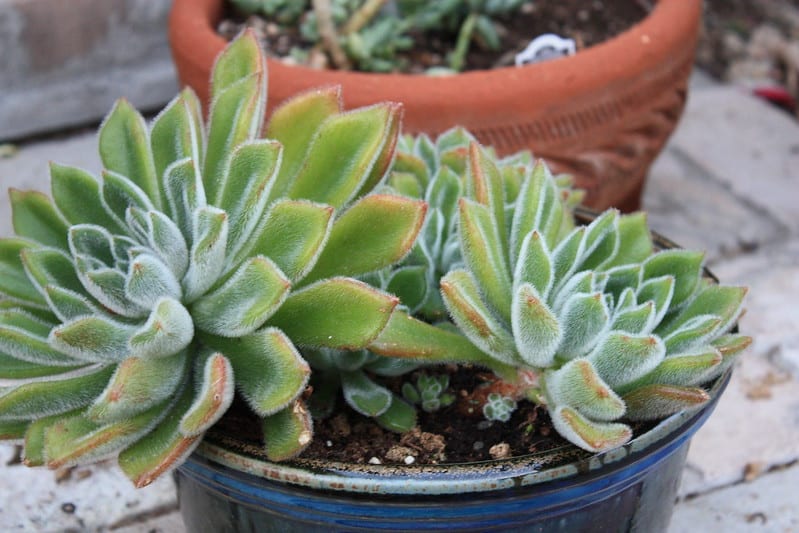The Echeveria “Doris Taylor” is an attractive succulent it growth up to 2 inches tall, which forms rosettes of fleshy leaves.
Stems are short with numerous horizontal offsets.
The entire plant, including flower, is cover with glistening hairs, similar to Echeveria setosa but more numerous.
Leaves are pale-green with red margins in full sun, up to 3.6 inches long and up to 1.2 inches wide.
Flowers are yellow inside red shading to the yellow outside and appear in spring to fall.
The echeveria Doris Tayler is a hybrid between echeveria pulvinata tuby and echeveria setosa, created by Dr.W.Taylor and name after this wife.
This woolly plant is a favorite Echeveria hybrid of many succulent growers! Its green leaves are covered in fine white “hairs” that give it a fuzzy appearance.
When happily stressed, the tips of the leaves turn a dark red. Perfect for indoor growers.
Tips to take care of the Echeveria “Doris Taylor”
Substratum
Porous and loose soil, it is advisable to use a special substrate for crass plants and cacti that contains river sand and small aggregates in different sizes, to ensure perfect drainage.
Transplant
If necessary, if you want to transplant the plants, you will Moderately water the plants, during spring and summer, try not to wet the leaves especially avoid wetting the center of the rosette to avoid rot, it is recommended that the water goes directly to the ground.
The amount should be moderate and the risks must be distanced waiting for the substrate to dry between them.
Pots
Use a pot of slightly larger size, we will incorporate a substrate of special quality for crass plants, if we have cut dried roots, we will wait a week before watering so that the wounds heal.
If necessary we can add a small amount of special liquid fertilizer for succulent plants, along with the irrigation water, monthly in spring and early summer.
Bright Light and Temperature
This Echeveria enjoys plenty of light.
Plant the pulidonis echeveria in full sun or a sunny spot with some partial shade in the garden or near a south or west-facing window.
Good lighting will prevent the ‘stretching’ of the plant which encourages the redness along the edge of the plants.
The plant enjoys warm climates.
The Ideal growing temperatures are between 50 and 70 degrees Fahrenheit.
It is not a frost-hardy plant and advisable to keep the plant out of chilly winds during the colder months of the year.
It is a suitable plant for warm winter climates, does not like cold or resists frost.
As temperatures fall there is mos risk for the plant to die.
So make sure to take care of it.
Remove the dried leaves from the base of the plant to keep it healthy and the inflorescences dry.
If the weather is cold or wet it is advisable to grow the plants in pots to be able to protect during cold or rainy times.
It is advisable to use clay pots that perspire better, airing the substrate easily, so we will prevent the roots or neck of the plant from rotting.
If necessary, we will transplant the plants, we will use a pot of slightly larger size, we will incorporate a substrate of special quality for crass plants, if we have cut dried roots, we will wait a week before watering so that the wounds heal.
Propagation
It can be reproduced by seeds but it is a long process to obtain medium plants.
It can be reproduced by separating the small rosettes that grow around it, so we will get plants faster, also by leaf cutting.
The wound on the rosette or the leaf should heal before it is placed on the ground for a week.
This plant, like other fleshy plants, can be attacked by cottony cochineal in hot and humid climates, we will have to treat the plants with insecticides against cochineals for their control and elimination.
Its main enemies are intense cold, poor drainage, excessive irrigation or poor aeration.
You have to keep the plants in optimal conditions for good development.
Echeverias Pest and Diseases
This plant is fairly pest and disease free and even resistant to deer, however, it can be susceptible to mealybugs.
Especially if the dead leaves are not removed regularly.
If you find your plant has become lunch to mealybugs, get rid of them by wiping down your plant with some rubbing alcohol.
Fertilizer
As for the subscriber, although it is not a demanding plant, it will always grow, bloom more and be more beautiful if we provide nutrients.
Here the special fertilizers for cacti and succulents especially in spring, are recommended at the dose indicated by the manufacturer.
